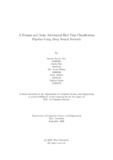| dc.contributor.advisor | Mostakim, Moin | |
| dc.contributor.advisor | Reza, Md Tanzim | |
| dc.contributor.author | Riya, Aparna Sarker | |
| dc.contributor.author | Roy, Arpita | |
| dc.contributor.author | Fahim, Md. Abrar | |
| dc.contributor.author | Tasnim, Zarin | |
| dc.contributor.author | Islam, Rakibul | |
| dc.date.accessioned | 2023-10-15T03:44:02Z | |
| dc.date.available | 2023-10-15T03:44:02Z | |
| dc.date.copyright | ©2022 | |
| dc.date.issued | 2022-09-29 | |
| dc.identifier.other | ID 18301194 | |
| dc.identifier.other | ID 18101332 | |
| dc.identifier.other | ID 18301006 | |
| dc.identifier.other | ID 18101352 | |
| dc.identifier.other | ID 17101478 | |
| dc.identifier.uri | http://hdl.handle.net/10361/21798 | |
| dc.description | This thesis is submitted in partial fulfillment of the requirements for the degree of Bachelor of Science in Computer Science and Engineering, 2022. | en_US |
| dc.description | Cataloged from PDF version of thesis. | |
| dc.description | Includes bibliographical references (pages 29-30). | |
| dc.description.abstract | Birds are an important category of animals that ecologists keep track of utilizing
autonomous recording units as a key indication of environmental health. Because
of the consequences of climate change and the rising number of endangered species,
many experts suggested developing an animal species recognition system to help
them in specialized research. Researchers can improve their ability to assess the
state of biodiversity and its patterns in crucial ecosystems by precise sound detection and categorization, which is supported by machine learning, allowing them to better support global conservation efforts. However, producing analysis outputs
with high precision and recall remains a difficulty. Due to a lack of appropriate
methods for efficient and accurate extraction of interest signals, the vast bulk of
data remains unexplored (e.g., bird calls). Moreover, due to strong source-domain specific features and artificial/natural noises, these acquired raw data create different distributions in datasets. So, to ensure a generalized feature learning, domain adaptation [1] techniques will be implemented in this work to make the networks familiar towards both acquisition sensor noises and background noises without having to do intensive dataset specific augmentations. We used 3 popular and powerful
DNN models, including CNN, VGG19 and ResNet50. Out of them, for the bird
species classification task VGG19 achieved the best accuracy of 96.02% in testing and 94.01% in training. To the best of our knowledge, this will guide towards convenient and deployable in real life models which will allow future works into the pipeline to ensure better coverage. | en_US |
| dc.description.statementofresponsibility | Aparna Sarker Riya | |
| dc.description.statementofresponsibility | Arpita Roy | |
| dc.description.statementofresponsibility | Md. Abrar Fahim | |
| dc.description.statementofresponsibility | Rakibul Islam | |
| dc.description.statementofresponsibility | Zarin Tasnim | |
| dc.format.extent | 41 pages | |
| dc.language.iso | en | en_US |
| dc.publisher | Brac University | en_US |
| dc.rights | Brac University theses are protected by copyright. They may be viewed from this source for any purpose, but reproduction or distribution in any format is prohibited without written permission. | |
| dc.subject | Biodiversity | en_US |
| dc.subject | Domain adaptation | en_US |
| dc.subject | Classification | en_US |
| dc.subject | VGG19 | en_US |
| dc.subject | CNN | en_US |
| dc.subject | ReLU | en_US |
| dc.subject | RESNET50 | en_US |
| dc.subject.lcsh | Machine learning | |
| dc.subject.lcsh | Neural networks (Computer science) | |
| dc.title | A domain and noise adversarial bird tune classification pipeline using deep neural network | en_US |
| dc.type | Thesis | en_US |
| dc.contributor.department | Department of Computer Science and Engineering, Brac University | |
| dc.description.degree | B.Sc. in Computer Science | |

